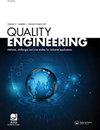基于云模型理论和TOPSIS方法的小品种大批量工业制造过程评价
IF 2.2
4区 工程技术
Q4 ENGINEERING, INDUSTRIAL
引用次数: 1
摘要
失效模式与影响分析(FMEA)是各种产品和工艺设计中最常用的识别和最小化潜在失效的技术之一。传统的FMEA方法由于通用的评级尺度和专家基于数字的评估而具有局限性,可能无法产生预期的结果。本研究采用云模型理论(CMT)与理想解相似性偏好排序分层技术(TOPSIS)相结合的混合方法来处理卷烟制造业风险和故障识别中的不确定性,包括随机性和模糊性。结果表明,该方法对生产过程中的故障分类更为有效。研究结果表明,在卷烟制造机械的三个基本单元中,大多数影响卷烟制造过程生产的故障属于MAX,它支持过滤和过滤后卷烟的检查。研究确定了突出的问题领域,管理者必须给予特别重视,以提高生产过程的效率。本研究的意义在于识别具有等级顺序的失效模式,这些失效模式对于最终达到客户满意度和生产效率的期望水平是非常有价值的。本文章由计算机程序翻译,如有差异,请以英文原文为准。
Evaluation of manufacturing process in low variety high volume industry with the coupling of cloud model theory and TOPSIS approach
Abstract Failure Mode and Effect Analysis (FMEA) is one of the most commonly used techniques for identifying and minimizing potential failures in various products and process designs. The traditional FMEA approach has limitations due to generic rating scales and experts' number-based assessments, which might not produce the desired results. The current research uses a hybrid approach of coupling Cloud Model Theory (CMT) with hierarchical Technique for Order of Preference by Similarity to Ideal Solution (TOPSIS) to deal with uncertainty, including randomness and fuzziness in the identification of risks and failures in a cigarette manufacturing industry. The results show that this hybrid approach is more effective in classifying failures in the production process. The findings reveal that out of the three fundamental units of cigarette manufacturing machinery, most of the failures affecting the production of the cigarette manufacturing process belong to MAX, which supports filtration and inspection of filtered cigarettes. The study identifies salient problem areas that the managers must give special attention to enhance the production process's efficiency. The significance of the study lies in the identification of failure modes with rank order which the managers will find quite valuable for finally achieving the desired level of customer satisfaction and production efficiency.
求助全文
通过发布文献求助,成功后即可免费获取论文全文。
去求助
来源期刊

Quality Engineering
ENGINEERING, INDUSTRIAL-STATISTICS & PROBABILITY
CiteScore
3.90
自引率
10.00%
发文量
52
审稿时长
>12 weeks
期刊介绍:
Quality Engineering aims to promote a rich exchange among the quality engineering community by publishing papers that describe new engineering methods ready for immediate industrial application or examples of techniques uniquely employed.
You are invited to submit manuscripts and application experiences that explore:
Experimental engineering design and analysis
Measurement system analysis in engineering
Engineering process modelling
Product and process optimization in engineering
Quality control and process monitoring in engineering
Engineering regression
Reliability in engineering
Response surface methodology in engineering
Robust engineering parameter design
Six Sigma method enhancement in engineering
Statistical engineering
Engineering test and evaluation techniques.
 求助内容:
求助内容: 应助结果提醒方式:
应助结果提醒方式:


